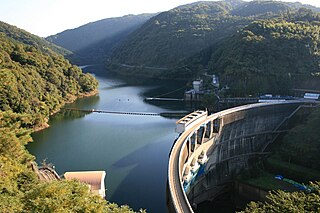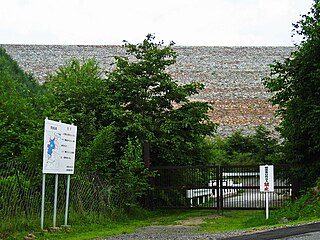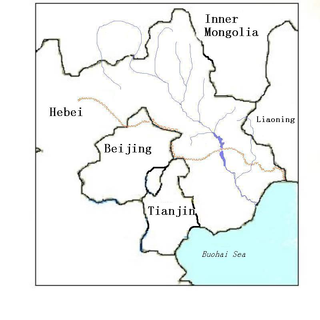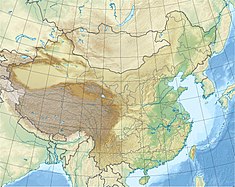
The Grande Dixence Dam is a concrete gravity dam on the Dixence at the head of the Val d'Hérémence in the canton of Valais in Switzerland. At 285 m (935 ft) high, it is the tallest gravity dam in the world, fifth tallest dam overall, and the tallest dam in Europe. It is part of the Cleuson-Dixence Complex. With the primary purpose of hydroelectric power generation, the dam fuels four power stations, totaling the installed capacity to 2,069 MW, generating approximately 2,000 GWh annually, enough to power 400,000 Swiss households.

The Guangdong Pumped Storage Power Station or Guangzhou Pumped Storage Power Station is a pumped-storage hydroelectric power station near Guangzhou, Guangdong Province, China. Power is generated by utilizing eight turbines, each with a 300 megawatts (400,000 hp) capacity, totalling the installed capacity to 2,400 megawatts (3,200,000 hp). The generated power is sold to China Light and Power customers in Hong Kong. The power station was constructed in two stages, the first four turbines were completed in 1994 and the second four in 2000.

Fujiwara Dam (藤原ダム) is a gravity dam on a Tone River tributary in Gunma Prefecture of Japan. It is located 14 km (9 mi) north of Minakami. It was constructed between 1951 and 1957. The dam itself supports a single Francis turbine hydroelectric generator with a 23 MW capacity which was commissioned in 1957. The reservoir created by the dam serves as the lower reservoir for the 1,200 Tamahara Pumped Storage Power Station which was commissioned in 1986. The dam is 95 m (312 ft) high and withholds a reservoir with a 52,490,000 m3 (42,554 acre⋅ft) storage capacity.
The Ingula Pumped Storage Scheme is a pumped-storage power station in the escarpment of the Little Drakensberg range straddling the border of the KwaZulu-Natal and Free State provinces, South Africa. It is about 22 km (14 mi) North-East of Van Reenen.
The Shisanling Pumped Storage Power Station (十三陵抽水蓄能电厂) is a pumped-storage power station in Changping County of Beijing, China, near the Thirteen Tombs of the Ming Dynasty from where it got its name Shisanling, which means "thirteen tombs". The power station contains four reversible turbines for an installed capacity of 800 MW.

The Baishan Dam is an arch-gravity dam on the Second Songhua River near the town of Baishanzhen, Huadian, Jilin Province, China. The purpose of the dam is hydroelectric power generation and flood control. The dam supplies water to five turbine-generators in two different powerhouses for an installed capacity of 1,500 megawatts (2,000,000 hp) while it can also control a design 19,100 cubic metres per second (670,000 cu ft/s) flood. Additionally, it has a 300 megawatts (400,000 hp) pumped-storage hydroelectric generation capacity. It is named after Baekdu Mountain, near the city of Baishan.

The Yantan Dam is a gravity dam on the Hongshui River near Dahua County, Guangxi China. The main purpose of the dam is hydroelectric power production and it has an associated 1,210 MW power station consisting of 4 x 302.5 MW Francis turbine-generators.

The Wanjiazhai Dam is a gravity dam on the Yellow River on the border of Pianguan County, Shaanxi Province and Inner Mongolia Autonomous Region, China. The main purpose of the dam is water supply for the Wanjiazhai Water Control Project along with peak hydroelectric power generation. Construction on the dam began in 1994, the first generator went online in 1998 and the last in 2000.

The Amagase Dam (天ヶ瀬ダム) is an arch dam on the Uji River just upstream from Uji, Kyoto Prefecture, Japan. The main purpose of the dam is flood control but it supports a hydroelectric power station and creates the lower reservoir for the Kisenyama Pumped Storage Plant. The dam itself serves a 92 MW power station while the pumped-storage power station upstream has a 466 MW capacity. Construction on the dam began in 1955 and it was complete in 1964. The pumped-storage power station became operational in 1970. Both plants are owned by Kansai Electric Power Company.
The Yangyang Pumped Storage Power Station uses the water of the Namdae-Chun River to operate a 1,000-megawatt (1,300,000 hp) pumped storage hydroelectric power scheme, about 10 kilometres (6.2 mi) west of Yangyang in Gangwon Province, South Korea. The lower reservoir is created by the Yangyang Dam on the Namdae and the upper reservoir by the Inje Dam is located 937 metres (3,074 ft) above the power plant. Construction on the power plant began in 1996 and it was completed and dedicated on September 13, 2006. It is operated by Korean Midland Power Co., a subsidiary of Korea Electric Power Company and was completed at a cost of ₩1.1 trillion won. The first generator was operational on February 23, 2006 and the last August 10, 2006.
The Dniester Pumped Storage Power Station is a pumped storage hydroelectric scheme that uses the Dniester River 8 kilometres (5.0 mi) northeast of Sokyriany in Chernivtsi Oblast, Ukraine. Currently, 3 of 7 324 megawatts (434,000 hp) generators are operational and when complete in 2017, the power station will have an installed capacity of 2,268 megawatts (3,041,000 hp).

The Kazunogawa Pumped Storage Power Station is a pumped-storage hydroelectric power station near Kōshū in Yamanashi Prefecture, Japan. The station is designed to have an installed capacity of 1,600 megawatts (2,100,000 hp) and three of the four 400 megawatts (540,000 hp) generators are currently operational, for a total operational capacity of 1200 MW. Construction on the power station began in 1993 and the first generator was commissioned on 3 December 1999. The second was commissioned on 8 June 2000. The third on become operational on 9 June 2014, six year early due to post-power demand from the Great East Japan earthquake. The fourth and final generator is slate to be commissioned by 2024. It is owned by TEPCO and was constructed at a cost of $2.2 billion USD.

The Okutadami Dam (奥只見ダム) is a concrete gravity dam on the Tadami River, 26 km (16 mi) east of Uonuma on the border of Niigata and Fukushima Prefectures, Japan. The primary purpose of the dam is hydroelectric power generation and it supports a 560 MW power station which is the largest conventional hydroelectric power station in Japan. The dam also forms the second largest reservoir in Japan, next to that of the Tokuyama Dam.
The Hohhot Pumped Storage Power Station, also known by Huhehaote, is located 20 kilometres (12 mi) north of Hohhot in Inner Mongolia, China. It uses the pumped-storage hydroelectric method to generate electricity. The plant has an installed capacity of 1,224 megawatts (1,641,000 hp). Construction began in 2005 and the first generator was commissioned on 20 November 2014. The second generator was commissioned on 26 December 2014 and the final two were commissioned in June 2015.
The Upper Cisokan Pumped Storage Plant will be located 40 km (25 mi) west of Bandung in West Java, Indonesia and will occupy area in West Bandung Regency and Cianjur Regency. After receiving funding from the World Bank, construction on major works is expected to begin in 2015 and the first generator commissioned in 2019. It will have an installed capacity of 1,040 MW and will be Indonesia's first pumped-storage power plant. As a pumped-storage power plant, the project includes the creation of an upper and lower reservoir; the lower reservoir will be on the Upper Cisokan River a branch of Citarum River, while upper reservoir will be on the Cirumanis River, a branch of the Cisokan River.

The Vianden Pumped Storage Plant is located just north of Vianden in Diekirch District, Luxembourg. The power plant uses the pumped-storage hydroelectric method to generate electricity and serves as a peaking power plant. Its lower reservoir is located on the Our River, bordering Germany, and the upper is elevated above on the nearby Saint Nicholas Mountain. Construction on the plant began in 1959 and the first pump-generators were commissioned in 1962. A tenth pump-generator was installed in 1976 bringing the plant's installed generating capacity to 1,096 megawatts (1,470,000 hp). The plant generates an average of 1,650 gigawatt-hours (5,900 TJ) annually but of course consumes even more. Generally the efficiency of this energy storage method is around 70-80%. The plant is owned by Société Electrique de l'Our and RWE. Construction on an eleventh pump-generator began in 2010 and it is expected to be commissioned in 2013, which will bring the plant's installed capacity to 1,296 megawatts (1,738,000 hp).
The Pushihe Pumped Storage Power Station is a pumped-storage hydroelectric power station located 54 km (34 mi) northeast of Dandong in Kuandian County of Liaoning Province, China. It was constructed between August 2006 and September 2012. The power station operates by shifting water between an upper and lower reservoir to generate electricity. The lower reservoir was formed with the creation of the Pushihe Lower Dam on the Pushihe River, a tributary of the Yalu River. The Pushihe Upper Reservoir is located in a valley above the east side of the lower reservoir. During periods of low energy demand, such as at night, water is pumped from Pushihe Lower Reservoir up to the upper reservoir. When energy demand is high, the water is released back down to the lower reservoir but the pump turbines that pumped the water up now reverse mode and serve as generators to produce electricity. The process is repeated as necessary and the plant serves as a peaking power plant.
The Zhanghewan Pumped Storage Power Station is a pumped-storage hydroelectric power station located 50 km (31 mi) southwest of Shijiazhuang in Jingxing County of Hebei Province, China. Construction on the power station began on 6 December 2003 and the first unit was commissioned on 1 February 2009. The power station operates by shifting water between an upper and lower reservoir to generate electricity. The lower reservoir is created by the Zhanghewan Dam on the Gantao River which was built between 1977 and 1980, originally for irrigation. For this project the Zhanhewan Dam was raised 23 m (75 ft). The Zhanghewan Upper Reservoir is on Laoyemiao Mountain, above the west side of the lower reservoir. During periods of low energy demand, such as at night, water is pumped from Zhanghewan Lower Reservoir up to the upper reservoir. When energy demand is high, the water is released back down to the lower reservoir but the pump turbines that pumped the water up now reverse mode and serve as generators to produce electricity. The process is repeated as necessary and the plant serves as a peaking power plant.
The Hongping Pumped Storage Power Station is a 1,200 MW pumped-storage hydroelectric power station currently under construction about 11 km (6.8 mi) northwest of Hongping in Jing'an County of Jiangxi Province, China. Construction on the project began in June 2010. The first generator was commissioned in June 2014 and a second 1,200 MW phase is planned for completion in 2017. When fully operational, the power station will have an installed capacity of 2,400 MW. The power station operates by shifting water between an upper and lower reservoir to generate electricity. The lower reservoir is located on Hebei River and the upper reservoir is located in a valley above the north side of the lower reservoir. During periods of low energy demand, such as at night, water is pumped from Hongping Lower Reservoir up to the upper reservoir. When energy demand is high, the water is released back down to the lower reservoir but the pump turbines that pumped the water up now reverse mode and serve as generators to produce electricity. The process is repeated as necessary and the plant serves as a peaking power plant. It is operated by Jiangxi Hongping Pumped Storage Ltd.
The Huanggou Pumped Storage Power Station is a 1,200 MW pumped-storage hydroelectric power station currently under construction about 90 km (56 mi) north of Mudanjiang in Hailin County of Heilongjiang Province, China. Construction on the project began on 8 May 2014. The first generator is scheduled to be commissioned in January 2019 and the project complete in January 2020. The power station operates by shifting water between an upper and lower reservoir to generate electricity. The lower reservoir, Lianhua Reservoir, is located on the Mudan River and the upper reservoir is located in a valley above the north side of the lower reservoir. During periods of low energy demand, such as at night, water is pumped from Huanggou Lower Reservoir up to the upper reservoir. When energy demand is high, the water is released back down to the lower reservoir but the pump turbines that pumped the water up now reverse mode and serve as generators to produce electricity. The process is repeated as necessary and the plant serves as a peaking power plant. It is operated by the State Grid Corporation of China.















